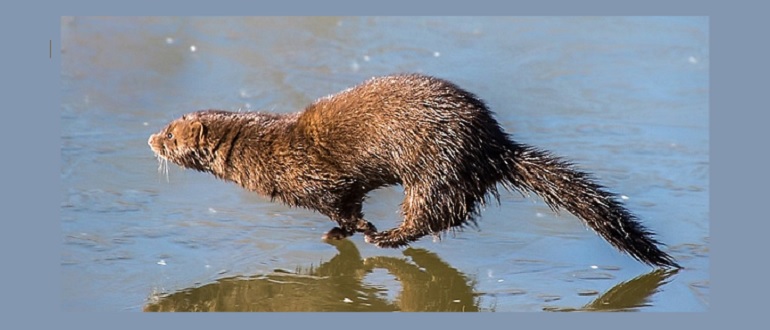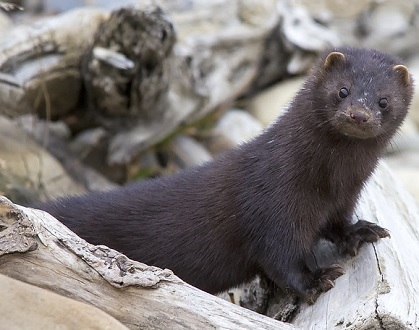American mink (Neovison vison) – by Konrad Kuiper -CC-BY-NC-SA-2.0
GET TO KNOW American Mink
Born wild and free, American mink are both utterly fierce and softly beautiful. Wrapped in magnificent coats, mink are extremely energetic and athletic animals. Though small in stature – only two to four pounds on average – they are fearless and face the world with an outsized dose of vim, vigor, and vitality. You may have been lucky enough to glimpse one running along the banks of the Rouge River.
Mink are high-level predators of riparian zones where they are equally skilled at climbing trees and diving deep in water. They can dig underground, and they can stay submerged underwater.
FUN FACT: American mink are generally nocturnal, solitary, and silent. Most communication with other mink is via scent markings. However, mink are capable of making a variety of sounds. Like most creatures, they will make shrill screams when injured or fighting. They are also known to hiss when angry and to chuckle and purr like a cat when happy.
They can travel distances by loping along the ground or swimming through the water. And, when actively hunting, mink may chase prey underground into burrows or underwater into lodges. All in all, and pound for pound, mink are some of the toughest and fiercest of all creatures.
Yet mink also sport one of the most beautiful and luxurious of fur coats in the animal kingdom. American mink are members of the Mustelidae family of mammals. Like mink, most species of Mustelidae – including European mink, stoats, weasels, badgers, wolverines, and otters – are tough survivalists and fierce predators. And while all members of the family have magnificent coats, it is the mink and stoats (a.k.a.: ermine) that have been specifically victimized for the beauty of their fur.
Unfortunately, even with a decline in public acceptance of full fur garments, many fur farms still operate within the U.S. and raise captive mink in inhumane conditions in order to supply the demand for fur trim. It is currently estimated by the Humane Society International that approximately 3.1 million mink are bred in the U.S.
Additionally, American mink were once exported to stock European mink farms. There escapees survived and returned to the wild where they thrived. Unfortunately, wild American mink populations are currently outcompeting their European cousins, and wild European mink are now critically endangered.
In the past year, both American and European mink have faced an additional threat from the SARS-CoV-2 virus (Covid-19). To date, mink appear to be the only animal, other than humans, to experience widespread serious illness and death from Covid-19. Captive mink (already weakened from being bred and confined in inhumane conditions) held in mink farms across both North America and Europe have experienced severe outbreaks of the disease. In November 2020, in response to severe Covid-19 outbreaks, the government of Denmark euthanized 17 million mink on mink farms where the disease was spreading back and forth between humans and mink. Due to a fear of the potential of disease variants developing in the mink, the country decided to euthanize the entire mink population. Unfortunately, the euthanized mink were already doomed to be killed for their fur in the name of fur linings and pompoms.
HABITAT AND LIFE CYCLE
American wild mink thrive in woodlands along the edges of lakes, rivers, and streams across most of North America. Since they are high-level aquatic predators, their preferred prey includes fish, crayfish, frogs, and waterfowl. However, as needed, they will also hunt insects, mammals, and forest birds. Mink are believed to hunt and store excess meat for winter survival and to remain safely inside their dens for days at a time during the coldest weeks of winter.
The luxurious coats of mink have a dense under-layer for warmth and an oily, waterproof outer-layer designed for life at the water’s edge. While the suburb physical abilities of mink are well documented, the more personal aspects of their lives remain a bit of a mystery. There are some conflicting accounts and descriptions, but in general it is believed that mink are very solitary creatures that vigorously mark and defend large personal territories.
In general, adult male mink will not tolerate the presence of another adult males and will only tolerate a degree of territory overlap with an adult female if she is also a mating partner. Males and females do not form bonds, and males do not share in the care or defense of the young. Rather, both males and females appear to mate with numerous partners during each February-March mating season. Expectant female mink build a birthing dent and use fur, feathers, and leaves to create soft nests for the babies. Mink litters range from two to ten blind and helpless kits. The babies are generally born in May, and while adult mink have few natural predators (primarily great horned owls, bobcats, coyotes, and the occasional river otter), baby mink are highly susceptible to predation by many animals. However, young mink grow quickly. They begin hunting by eight weeks and leave the den during their first fall season to establish independent territories.
TAKE ACTION
Although it is believed that mink can have a lifespan of more than ten years, the average wild mink lifespan is considered to be only three years. While some do fall victim to predation, many are still victims of fur trapping. (Fur trapping is still allowed in more than 40 US states. California was the first state to ban trapping, and several others are considering various bills regarding trapping and the fur industry.) Michigan still allows trapping with steel-jaw leghold traps for many animals including mink. Concerned individuals should contact their state representatives regarding trapping laws in Michigan.
Wild mink populations are also at risk from ongoing habitat destruction of riparian woodlands in the name of development. Additionally, like all animals who consume fish, mink suffer from the effects of chemical/heavy metal toxins that accumulate in the fish. Both mercury and PCB’s (used as stabilizers in plastics, hydraulic fluids, lubricants, etc.) are common contaminants that are absorbed by fish and transferred up the aquatic food chain.
FOTR works restore proper riparian zones along our waterways and to monitor/reduce the toxins that wash into the water from such sources as combined sewer overflows, storm water run-off, and illegal dumping. Please join us in helping to protect the natural beauty and integrity of our watershed riparian zones for amazing creatures like the American mink.
Categories
-
News & EventsLearn more about upcoming FOTR events and projects

